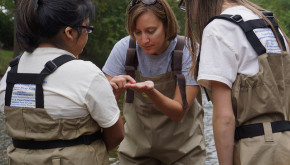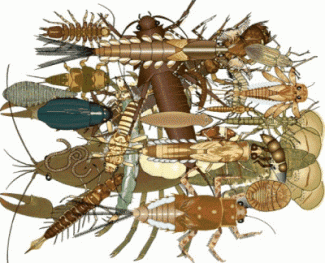
By Cynthia Tait, Forest Service Regional Aquatics Ecologist, Intermountain Region
What is an aquatic macroinvertebrate? Let's break down the term. "Aquatic" means water, "macro" means big (or big enough for us to see without using a microscope) and "invertebrate" means without a  backbone. Many macroinvertebrates make their homes amid rocks, leaves, and sediment in stream beds. Some common examples of these animals are: crayfish, clams, snails, aquatic worms, and a variety of aquatic insect larvae, such as stoneflies, caddisflies, mayflies, dragonflies, and damselflies. In addition to being an integral component of aquatic ecosystems, macroinvertebrates are also used to draw conclusions about the overall health of our streams.
backbone. Many macroinvertebrates make their homes amid rocks, leaves, and sediment in stream beds. Some common examples of these animals are: crayfish, clams, snails, aquatic worms, and a variety of aquatic insect larvae, such as stoneflies, caddisflies, mayflies, dragonflies, and damselflies. In addition to being an integral component of aquatic ecosystems, macroinvertebrates are also used to draw conclusions about the overall health of our streams.
Aquatic macroinvertebrates are a vital part of aquatic and terrestrial food chains. They graze on algae (and each other!) and break down leaves and sticks that fall into the water. They are, in turn, fed on by fish and salamanders. Aquatic insects that emerge from the water in swarms, such as mayflies, midges, and dragonflies, are important food sources for riparian song birds and bats.
Aquatic macroinvertebrates are also good indicators of water quality. In fact, the EPA and most states in the U.S. monitor water quality by measuring the abundance and diversity of macroinvertebrate communities. Different types of macroinvertebrates tolerate different stream conditions and levels of pollution. Depending on which macroinvertebrates are found in a stream, predictions about water quality can be made. For example, caddisflies, mayflies, and stoneflies prefer cold, clear, well-oxygenated water (like trout do) and cannot live in polluted water with excess nutrients and sediment. If these insects are present in a stream, the water quality there is probably good. Other macroinvertebrates, such as dragonflies, blackflies, midges, and flatworms, are more tolerant of warm, muddy, and nutrient-rich conditions, and their presence at a site might suggest lower water quality.
Macroinvertebrates are collected using a net positioned on the stream bed as rocks and sediment are overturned upstream. After each catch, the organisms are identified, sorted by species and recorded on a data sheet. At the end of the stream monitoring session, some simple calculations based on which macroinvertebrates are present creates an ecological rating which estimates water quality of the site. Currently, only a fraction of waterbodies in the U.S. are monitored by state and federal agencies, and we know very little about the condition of many streams and rivers, even in our own backyards. It is up to volunteers to do additional monitoring to protect the health of our streams.
Stream monitoring is a fun, easy way to determine if your local stream has been impacted by pollution sources. There are many state programs throughout the country that involve and train volunteers for macroinvertebrate stream monitoring. Check out some typical websites, below:
http://www.fairfaxcounty.gov/nvswcd/monitoring.htm
http://streamwatch.org/volunteers
http://www.dnr.maryland.gov/streams/streamWaders.asp
http://www.nj.gov/dep/wms/bwqsa/vm/biomon.html
Illustration courtesy of Cacapon Institute and artist Jennifer Gillies.


